
18 minute read
The Elk's Cookbook Blueberry Zucchini Bread
THE ELK’S COOKBOOK
BLUEBERRY ZUCCHINI BREAD WITH LEMON GLAZE
Advertisement
This month The Elk’s Cookbook offers another sneak peek at one of the recipes in the new Class of 1971 Feed the Pack Cookbook. All proceeds from this fundraiser will go to a vocational scholarship for a recipient in the first graduating class at the new HHHS school location. If you would like to purchase a cookbook, send your name, address, phone number, and how many cookbooks you want to Debbie Kennedy Abel, P. O. Box 431, Pursglove, WV 26546. They are an excellent gift for just $19.71 each. Here is Patti Robinson’s Blueberry Zucchini Bread with Lemon Glaze, just in time for all of the end of season zucchini you have on hand.
Blueberry Zucchini Bread
• 3 Eggs • 1 C. Vegetable Oil • 1 T. Vanilla Extract
• 2 ¼ C Shredded Zucchini (or yellow Squash can be substituted) • 3 C All-Purpose Flour • 1 t. Baking Powder • ¼ t. Baking soda • 1 Pint Fresh Blueberries Preheat Oven to 350 degrees • Prep: 15 min • Bake: 50 min
Coat two large loaf pans or four mini loaf pans with the magic cake pan release recipe or lightly grease with shortening/oil.
Blueberry Zucchini Bread
Step 1: In a large bowl, beat together eggs, oil, vanilla, and sugar. Step 2: Fold in the shredded zucchini. Beat in the flour, salt, baking soda, and baking powder. Gently fold in blueberries. Step 3: Pour into prepared pans and bake for 50 minutes or until a toothpick comes out clean. Cool for 20 minutes and transfer to wire racks to cool completely.
Lemon Glaze
• 1 C. Powdered Sugar • 1 T. Lemon Juice (fresh is best) • 1 T. Heavy Whipping Cream Lemon Glaze
Step 1: Whisk together powdered sugar, lemon juice, and heavy cream. Step 2: Drizzle on top of cooled bread.
HARVESTING THE FRUITS OF YOUR LABOR
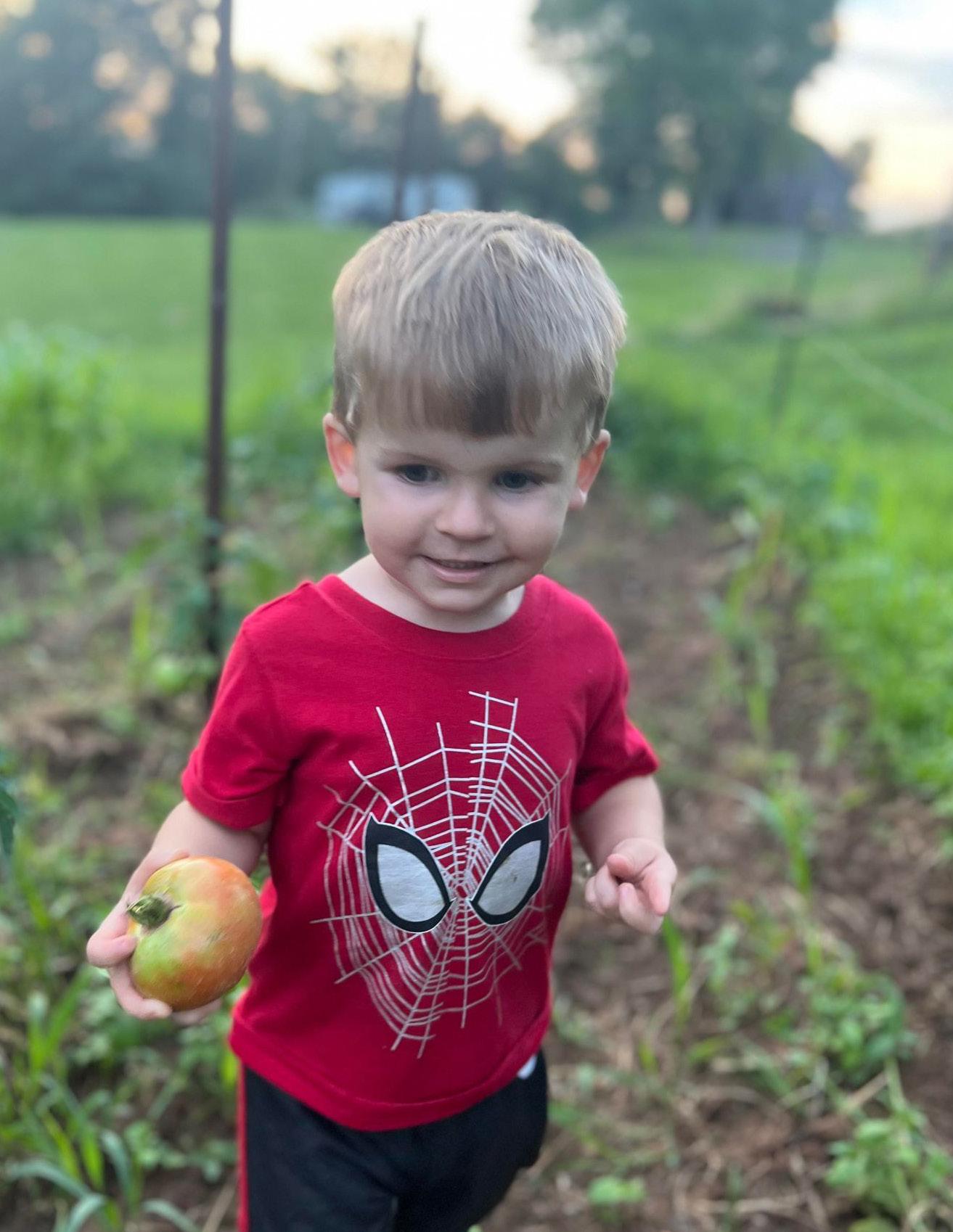
– Laura Boggess Shafer
This month ERL is featuring “Show Me Your Harvest” as we share some of our Elk River locals' delicious canned goods.
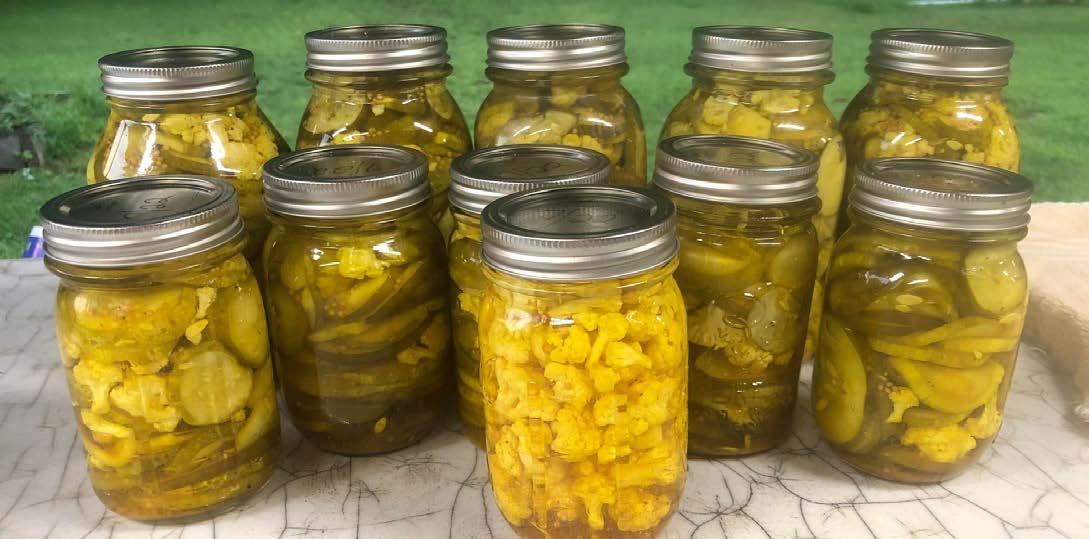
Meet Laura & Frank Shafer
Our friend, Laura Boggess Shafer of Clendenin (Gabe Road), does an amazing job of canning. She said, ‘Our cellar was already here when we moved here in 1983. I had never canned before. My husband, Frank, said we could garden and I could can. I was 18 years old and I didn’t know anything about gardening.” She remembers Frank buying her a Kerr canning book and directing her to neighbors on each side of them for canning advice. She said, “Marilyn Rose was in her 50’s at that time and Darlene Light was in her 70’s. Darlene was Cindy Gibson's grandmother and has since passed away and our son, Lacon, his wife Shannon, and their two sons, Wade and Marshall, live in her house now. I wished I had written down a few of Darlene’s recipes.” It’s funny now that I am older and experienced, I’m the one who people call for canning recipes and the signs,“ said Laura. By signs she means the signs of the almanac. “Some people plant by signs, castor animals, and wean babies by the almanac signs. We pickle by the signs. You do not pickle when the signs are in the bowels or the feet. The old tale is if you pickle in the bowels it will be fowl. If you pickle in the feet it will stink. The almanac signs are also on the Poca Valley Bank calendar each year. Laura said she recently talked to her mom about canning being a lost skill today. When her mom was younger, her job was to wash jars. Her older sister and their mom did the actual canning so she never really learned. “When I was little, grandpa called me his pickle taster,” said Laura. “He would set me up on the counter and have me taste the vinegar mixture for beets and pickles. I was around 8 or 9 years old. Grandma died when I was 12 so they quit canning.” “The art of canning seems to come and go, but I do think people are canning more than ever now,” Laura added. She is in a Water Bath Only Canning group on Facebook and she is amazed at how many older people are learning to can. “There are 60- and 70-year olds just learning to can in this Facebook group. Maybe people my mom's age didn’t learn or want to learn when they were younger, but they are learning now. I do think it’s coming back out of concern and necessity.” Laura said their cellar is over 80 years old. “We have lived here for 39 years this December, and Frank’s uncle lived here 47 years before us. “I’m not sure exactly when it was built, but it was built well!,” she said. It was remodeled approximately 7-8 years ago. Their son worked for a company where they removed wire racks.
“They gave them to him to junk at first but when the wooden shelves in our cellar started to rot, Lacon and a friend, Steven, repurposed them for

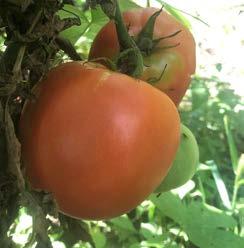


us. Frank, our daughter, Miranda Shafer King, and I moved all the jars and they took out all of the old wood and replaced it with the metal shelving. The racks have plastic coating on them and each section holds 54 quarts.” Both of Frank and Laura’s children garden and can. Lacon is an electrician and does HVAC work and his wife, Shannon, is an RN. They help Laura can and Shannon is learning to can as well. Miranda, her husband, John, and their son, Kennedy, live in Gandeeville where she works for the WV Department of Agriculture. She and her husband farm and have over 200 head of cattle and he runs King Cattle Company. Laura added, “We butcher a cow and two hogs every year. We then can sausage, render lard, and make souse. It’s a family tradition to butcher right after Christmas. We also can deer, chicken, and chicken broth.” This year Laura recruited two of her young grandsons, Wade and Marshall, to help string green beans. She said even though Marshall ate a lot of the ones he strung that day, they still managed to can ten quarts. Lacon pulled carrots and they canned five pints in addition to picking two buckets of peppers. The first week in August, Laura and Miranda also canned 10 quarts of spaghetti sauce. “It smelled so good outside as it was cooking” said Laura.”It just takes forever to cook down but it tastes amazing and it is worth the wait.’” The Shafer’s cellar is full of a variety of canned meats, vegetables, pickles, relishes, and jellies. Just to name a few: sauerkraut, pickled corn, pickled beets with pineapples, dill beans, peppers and wieners, tomatoes, apples, jellies and more. The gorgeous colors line her cellar walls and it reminded me of a quote. “Mother Nature has the best box of crayons”. Laura said, “It gives you such a great feeling to look across the cellar and see the fruits of your labor, not to mention, to know that your family will have delicious food for the winter. I like making my own and not having to buy at the store. It tastes better. I love working with Frank and the kids. I love to hear the “ping” when the jars seal. It’s fabulous to see it done and on the shelves. My least favorite is cleaning up.”
Hot Peppers & Franks • 2 lbs. hot dog weiners, sliced into bite-sized pieces • 3 cups sugar • 1 t. salt • 1 pt. apple cider vinegar • 32 oz. bottle catsup • 1 clove garlic • 24-30 peppers, sliced (hot, mild or sweet) Mix everything but the peppers and hot dogs. Once mixed, add peppers and boil for 10 minutes and then add in the hot dogs during the last 4 minutes. Put in jars and process in a boiling water bath for 10 minutes.
Pickled Beets & Pineapples • 3 ½ quarts of baby beets • 2 cups cubed pineapple (canned) • 2 cups sugar • 3 ½ cup apple cider vinegar • 1 t. allspice • ½ t. ginger • 2-3 sticks of cinnamon • 1 ½ C. water (pineapple juice may be used as part of the water) Leave about 2 inches of the beet stem and all of the root on the beets. Wash and drain. Cook beets in boiling water until skins can be removed. Tie the spices in a cheesecloth bag and simmer with the sugar liquid until the liquid has a spicy/pickled flavor. Pack peets and pineapples into jars. Bring the vinegar solution to a boil and pour over the beets and pineapples. Process for 30 minutes in a boiling water bath.
Dill Beans (Note: These are different from pickled beans. My husband loves these and he hates pickled beans.) Pick green beans, clean and string, and leave whole. Cook until tender. Pack into pint jars. Add to each pint: • ½ t. red pepper • 1 clove garlic • 1 head of dill or 1 t. dill seed Heat to boil and then pour over beans: • 1 cups apple cider vinegar • ½ C. salt • 2 C. water Put on lids and let sit until they seal. Makes approximately 5-6 pints. Kitchen Floor Pickles Shared with Laura Shafer by Tommy & Suzanne Miller Using small to medium cucumbers, pack lightly in a gallon jar. Add: • 2 T. salt • 4 C. vinegar • 2 T. alum • 1 C. pickling spices Fill the rest of the jar with water to cover and let sit. After 30 days: Pour off the brine liquid and rinse the jar and cucumbers with clear water. Slice cucumbers and alternate in the jar with 4 C. sugar. Shake until all sugar is dissolved. These are ready to eat and will keep in the refrigerator until eaten (which won’t take long!!)



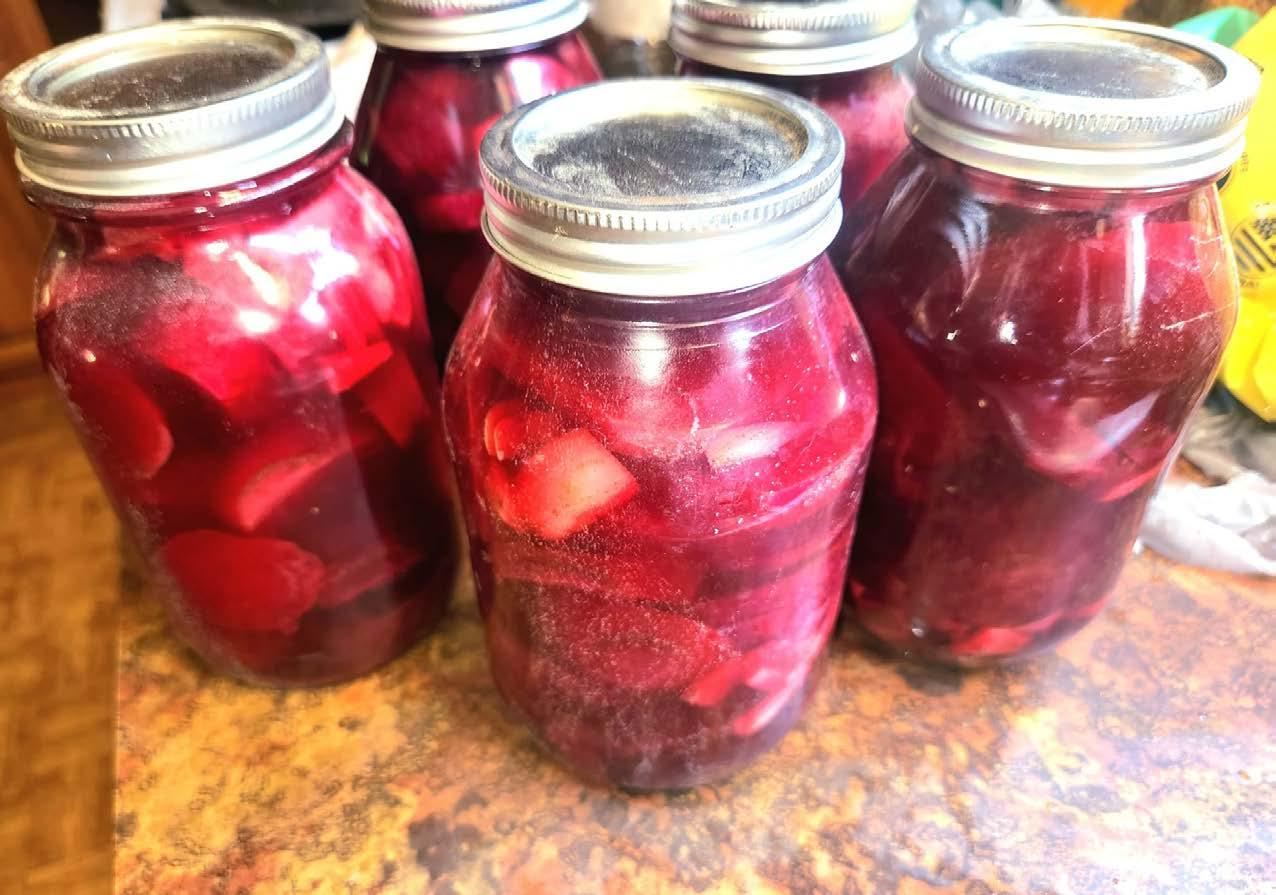
Meet Fred & Charlotte Hays
Frederick and Charlotte Hays of Elkview (Sand Run) have been busy this summer canning as well. Fred canned his first batch of squash for the season in early July. He said, “They used to say non-acid foods could only be done in the autoclave and with squash you would end up with mush. This is a simple recipe I use and the squash tastes just like it was fresh-picked when you open the jar. I will be able to have my fried squash during the winter. It turns out great.” Fred said If you google canned squash recipes, you will find several. The one that he prefers uses some apple cider vinegar, just enough to give the squash a little acidity. First clean the squash and blanche in a boiling cider-water mix for five minutes. Scoop chunks into jars and use the mix to cover them. Place them in a boiling canner for twenty minutes. They also canned a few quarts of pickled beets which was all that they had planted. Fred said, “I ordered bulk seed for this fall so it will grow a lot. I miss these when I don’t have them.” He makes them like his parents and grandparents did with extra cloves, allspice, nutmeg, cinnamon, and a little chopped onion in the mix. He adds cloves, tasting as he goes, until it is just right. He warns that a little goes a long way. You can google online for specific ratios of water to vinegar but Fred uses one-to one ratio. He added,”I used no sugar but I did use a sugar substitute so these will be really healthy.” If canning them, place them in a boiling water-canner for 20 minutes. Don’t forget: After using the beets out of the jar you can simply drop boiled eggs in the jar and the juice will pickle them also.”
If you like Chow Chow, Fred shared his recipe with us for his Chow Chow with extra turmeric. He said you can use other vegetables but as long as you use cabbage it is still considered Chow Chow.
Chow Chow I follow a recipe but I quadruple it. • A couple large heads of cabbage • 10 peppers • About a dozen jalapeño peppers • 5 large onions • 10 summer squash. Chop all that up. I use a food processor. Put it in a large container and add 1 1/2 cups of non-ionized salt, kosher. Cover and put in the fridge for 24 hours. Slowly drain the liquid from it as much as you can. Taste the raw veggies for salt. If too salty, let it set a few more hours and drain again. Next add a gallon of white vinegar in a large pot. To this add: cinnamon (3 Tbsp), turmeric (6 Tbsp), pickling spice (6 Tbsp), mustard from a bottle (5 Tbsp), dry mustard seed (5 Tbsp), cloves (2 Tbsp), ginger (5 Tbsp), red pepper flakes (about half a bottle), allspice (3 Tbsp.), and 10 cups of sugar. (I use artificial sweetener rather than sugar for my health.) Stir constantly over medium heat to dissolve the sugar; then add in your chopped veggies. Once they are cooking and pretty tender it is time to taste. This is the time to tweak if you want to alter the taste. If you are satisfied, pack it in sterilized jars and water bath 15 minutes for pints, 20 quarts, 40 half gallons.

Fred planted three crops of squash, a second crop of beets and another crop of Roma tomatoes. He is hoping to be gardening close to Christmas if the weather stays moderate. Also this year, Fred tried a new Lemon tomato which he said had a sweet, oldworld taste. Next year he plans to plant them again as well as Rutgers and Romas. Fred and Charlotte peeled and cored 8 lbs. of apples which yielded 9 pints of thick spicy apple butter. Fred said, “Squirrels and deer have stolen most of the apples but they left me a little. Cloves, cinnamon, allspice, real vanilla: really wakes you up. The only thing missing is a slight smoke taste. My grandma made it in a fifty-gallon copper cauldron hanging on a tripod over a wood fire, stirred all day with a wooden paddle.” He added, “The squirrels don’t seem to bother with our pears so maybe I will try making pear butter one year.” Also another great harvest for the Hays this summer were trumpet mushrooms. Fred said, “The woods were absolutely full of them after all of the rain we had this summer.” He likes to just fry them up crispy. “I put a little catsup on mine and then they taste just like fried oysters.” For the trumpet mushrooms, Fred said to wash them really well, splitting them down the stalk to get rid of sand. You can then fry in olive oil or roll in flour and then fry. He said just simple and fresh is best.





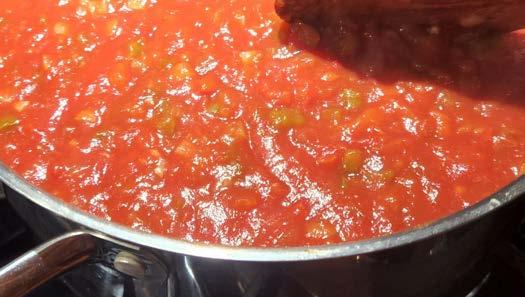

Meet Kathy & Ted Payne
Kathy and Ted Payne of Clendenin shared two of their favorite Salsa recipes and their recipe for Pickled Corn on the Cob. The first salsa recipe has a 12-oz. can of tomato paste added at the end. For the Zesty Salsa recipe, the vinegar is reduced to 1/4 cup and you add only 3 oz. of tomato paste to thicken during the last minute of cooking. Kathy says she likes the Zesty Salsa the best and Ted prefers the first salsa recipe, but he also likes mixing them together. Kathy learned canning basics from her mom. She said, “I helped her get everything ready to can when I was at home, but she canned everything herself. Ted and I have canned a lot of things that mom never attempted.” They have shelves of green beans, corn, kale, potatoes, tomatoes, apples, venison and smoked canned pork, apple butter, apple, blackberry and strawberry jellies.
Salsa • 4 C. tomatoes • 1 ½ t. salt • 1 t. Fresh minced garlic • 1 cup white vinegar • 1 cup onions • 4 T. sugar • 1 t. Cilantro • 1 ½ C sweet peppers • 1 C sweet banana peppers • ¾ hot banana peppers • ⅓ C jalapeno peppers • ¼ C habanero peppers • 1 12-oz can tomato paste Simmer all until onions, tomatoes, and peppers are tender. Add tomato paste stirring constantly until dissolved, being careful as it will stick. Heat lids. Pour into jars and seal. Check 5-6 hours later to be sure they are sealed. Let set a couple of days before eating.
Zesty Salsa Makes 4.5 pints • 5 C. chopped tomatoes • 2 ½ cups of chopped green bell peppers • 2 ½ cups of onion • 1 ¼ cup jalapeno peppers • ¼ cup apple cider vinegar • 3 cloves garlic • 2 T. pickling canning salt • 1 T. cilantro (optional) • Half of a small can of tomato paste (3 ozs.) Combine all ingredients over medium high heat and bring to a boil, stirring constantly. Reduce heat and boil gently, until slightly thickened, about 10 minutes. During the last minute add 3 oz. of tomato paste, stirring constantly, to thicken. Fill jars and place in a hot water bath for 20 minutes Kathy also shared her pickled corn recipe which she leaves on the cob and cans in gallon jars. That’s the way my mom and her mom always made it so I am partial to this recipe. Pickled Corn on the Cob Shuck corn and remove silk. Boil corn for five minutes. Drain. Place ears of corn in a wide mouth gallon jar or a crock. You can break the corn into smaller pieces if desired or leave them whole.
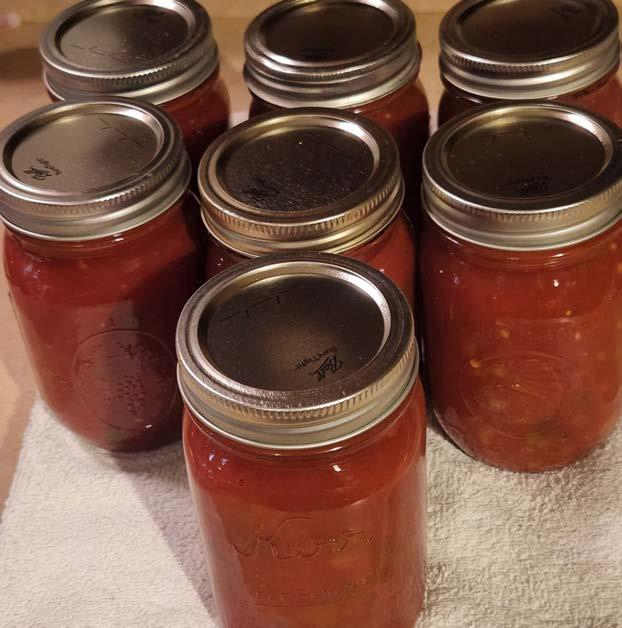

Make a brine of 1 cup canning salt to 1 gallon of water. Mix well. Pour over the corn and cover. If you are using a crock you will need to weigh down the corn with a couple of saucers or a plate. Keep in a cool place until pickled. Remove an ear and eat…until you run out of corn!

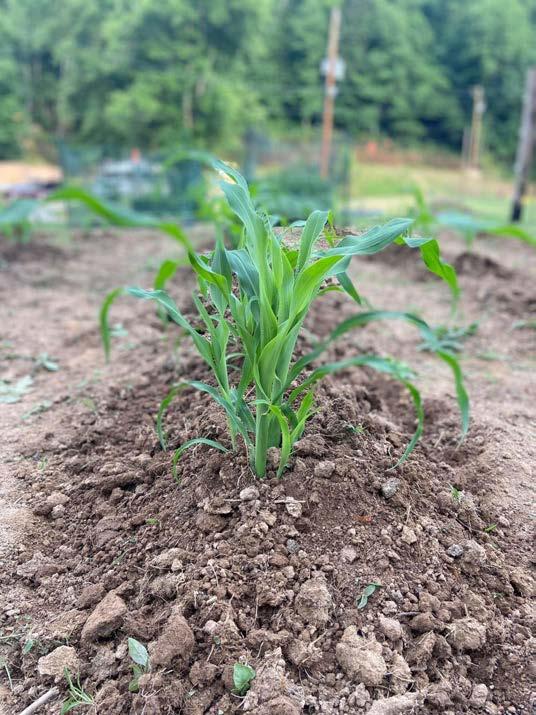
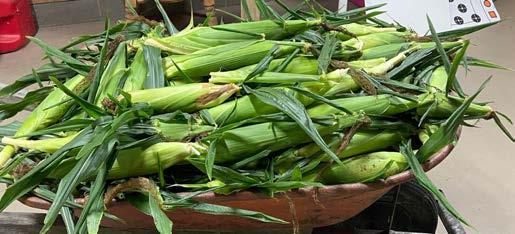
Meet Sarah Mitchell
This summer Sarah Mitchell of Elkview tried her hand at growing corn. Until this year she had grown potatoes, green beans and strawberries. She posted a photo of her new Ball Complete Book of Home Preserving Guide on Facebook and said, “Things just got serious!” She froze 28 ½ quarts of corn and canned 24 quarts of green beans. She also canned a good supply of taco soup for the fall season. She said, “I have no clue how many potatoes I have but it’s definitely enough to last me until next year. It's been a lot of hard work but totally worth it. There’s just something about growing your own food.”

Frozen Silver King Corn (80 days to maturity) Shuck corn and remove as much of the silk as possible. Bring water to a boil and boil ears for 3 minutes and then immediately dump into an ice bath to stop the cooking process. This process will need repeated depending on how many ears you have and how big of a pot you are using. Once cooled, remove ears from water and let air dry for a few minutes. This makes handling the ear easier. Remove kernels either with a knife or corn cutter. Place 3-4 cups in a quart size freezer bag. Remove as much air as possible from the bag, close and label. Place in the freezer immediately. Good for 10-12 months in the freezer.
Sarah also canned 13 pints of grape jelly for the first time this summer. “I’m really very pleased with how it turned out,” she said. “I am truly thankful for this bounty. We had such a hot, wet summer and I can see some of the effects on the ears of corn. Not all were fully developed, but I’m happy and blessed that this crop grew and withstood the wind!” She said next year she plans to double her efforts with green beans and skip the strawberries.





304.549.8778 • www.elkriverboutique.com 3 Main Street, Clendenin, WV 25045






